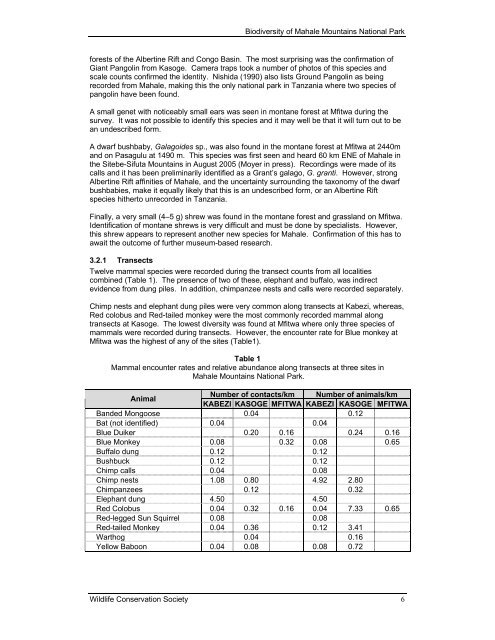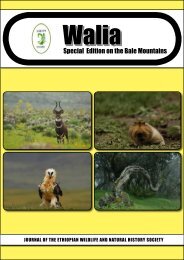Biodiversity of Mahale Mountains National Park, Tanzania | Report ...
Biodiversity of Mahale Mountains National Park, Tanzania | Report ...
Biodiversity of Mahale Mountains National Park, Tanzania | Report ...
Create successful ePaper yourself
Turn your PDF publications into a flip-book with our unique Google optimized e-Paper software.
<strong>Biodiversity</strong> <strong>of</strong> <strong>Mahale</strong> <strong>Mountains</strong> <strong>National</strong> <strong>Park</strong><br />
forests <strong>of</strong> the Albertine Rift and Congo Basin. The most surprising was the confirmation <strong>of</strong><br />
Giant Pangolin from Kasoge. Camera traps took a number <strong>of</strong> photos <strong>of</strong> this species and<br />
scale counts confirmed the identity. Nishida (1990) also lists Ground Pangolin as being<br />
recorded from <strong>Mahale</strong>, making this the only national park in <strong>Tanzania</strong> where two species <strong>of</strong><br />
pangolin have been found.<br />
A small genet with noticeably small ears was seen in montane forest at Mfitwa during the<br />
survey. It was not possible to identify this species and it may well be that it will turn out to be<br />
an undescribed form.<br />
A dwarf bushbaby, Galagoides sp., was also found in the montane forest at Mfitwa at 2440m<br />
and on Pasagulu at 1490 m. This species was first seen and heard 60 km ENE <strong>of</strong> <strong>Mahale</strong> in<br />
the Sitebe-Sifuta <strong>Mountains</strong> in August 2005 (Moyer in press). Recordings were made <strong>of</strong> its<br />
calls and it has been preliminarily identified as a Grant’s galago, G. granti. However, strong<br />
Albertine Rift affinities <strong>of</strong> <strong>Mahale</strong>, and the uncertainty surrounding the taxonomy <strong>of</strong> the dwarf<br />
bushbabies, make it equally likely that this is an undescribed form, or an Albertine Rift<br />
species hitherto unrecorded in <strong>Tanzania</strong>.<br />
Finally, a very small (4–5 g) shrew was found in the montane forest and grassland on Mfitwa.<br />
Identification <strong>of</strong> montane shrews is very difficult and must be done by specialists. However,<br />
this shrew appears to represent another new species for <strong>Mahale</strong>. Confirmation <strong>of</strong> this has to<br />
await the outcome <strong>of</strong> further museum-based research.<br />
3.2.1 Transects<br />
Twelve mammal species were recorded during the transect counts from all localities<br />
combined (Table 1). The presence <strong>of</strong> two <strong>of</strong> these, elephant and buffalo, was indirect<br />
evidence from dung piles. In addition, chimpanzee nests and calls were recorded separately.<br />
Chimp nests and elephant dung piles were very common along transects at Kabezi, whereas,<br />
Red colobus and Red-tailed monkey were the most commonly recorded mammal along<br />
transects at Kasoge. The lowest diversity was found at Mfitwa where only three species <strong>of</strong><br />
mammals were recorded during transects. However, the encounter rate for Blue monkey at<br />
Mfitwa was the highest <strong>of</strong> any <strong>of</strong> the sites (Table1).<br />
Table 1<br />
Mammal encounter rates and relative abundance along transects at three sites in<br />
<strong>Mahale</strong> <strong>Mountains</strong> <strong>National</strong> <strong>Park</strong>.<br />
Animal<br />
Number <strong>of</strong> contacts/km Number <strong>of</strong> animals/km<br />
KABEZI KASOGE MFITWA KABEZI KASOGE MFITWA<br />
Banded Mongoose 0.04 0.12<br />
Bat (not identified) 0.04 0.04<br />
Blue Duiker 0.20 0.16 0.24 0.16<br />
Blue Monkey 0.08 0.32 0.08 0.65<br />
Buffalo dung 0.12 0.12<br />
Bushbuck 0.12 0.12<br />
Chimp calls 0.04 0.08<br />
Chimp nests 1.08 0.80 4.92 2.80<br />
Chimpanzees 0.12 0.32<br />
Elephant dung 4.50 4.50<br />
Red Colobus 0.04 0.32 0.16 0.04 7.33 0.65<br />
Red-legged Sun Squirrel 0.08 0.08<br />
Red-tailed Monkey 0.04 0.36 0.12 3.41<br />
Warthog 0.04 0.16<br />
Yellow Baboon 0.04 0.08 0.08 0.72<br />
Wildlife Conservation Society 6
















